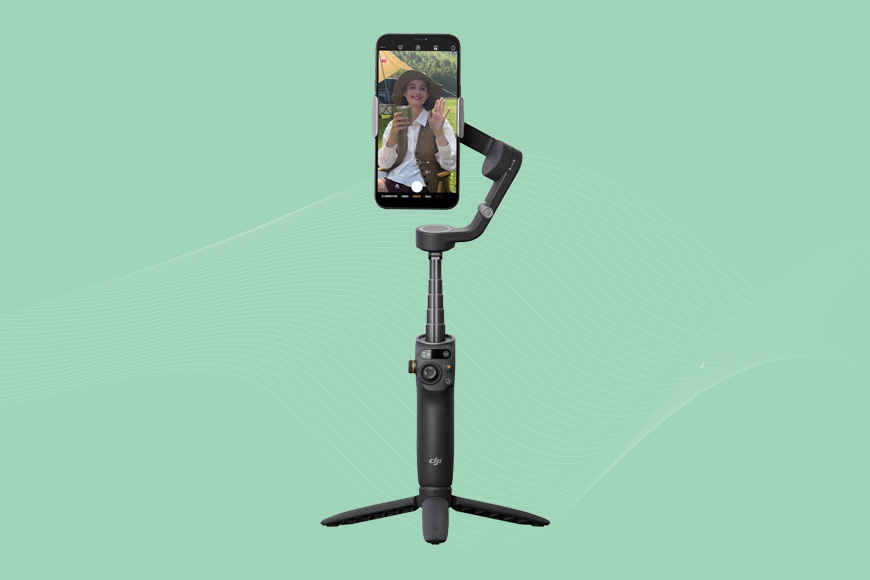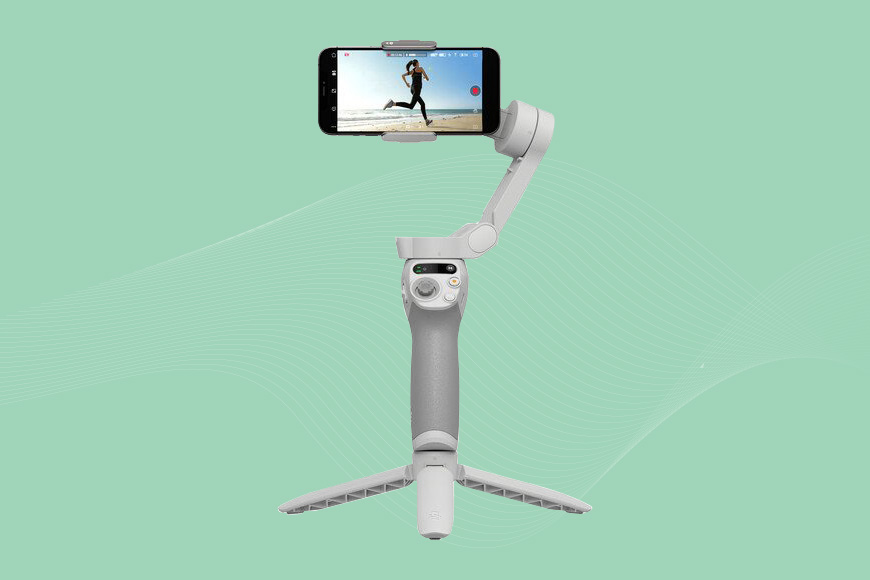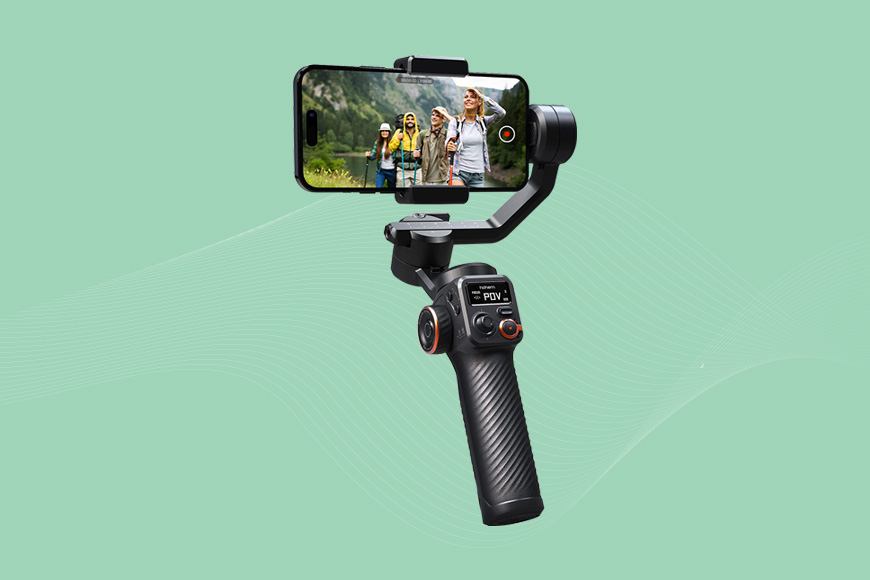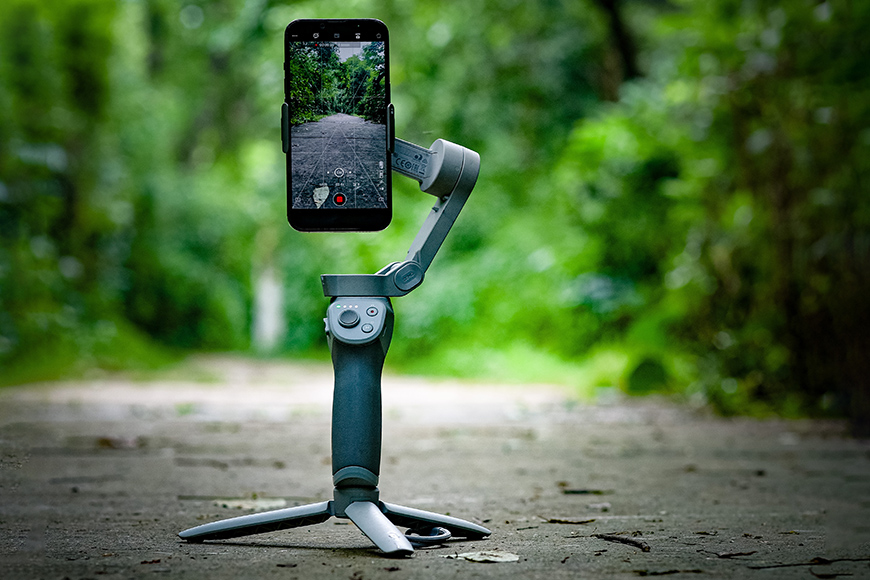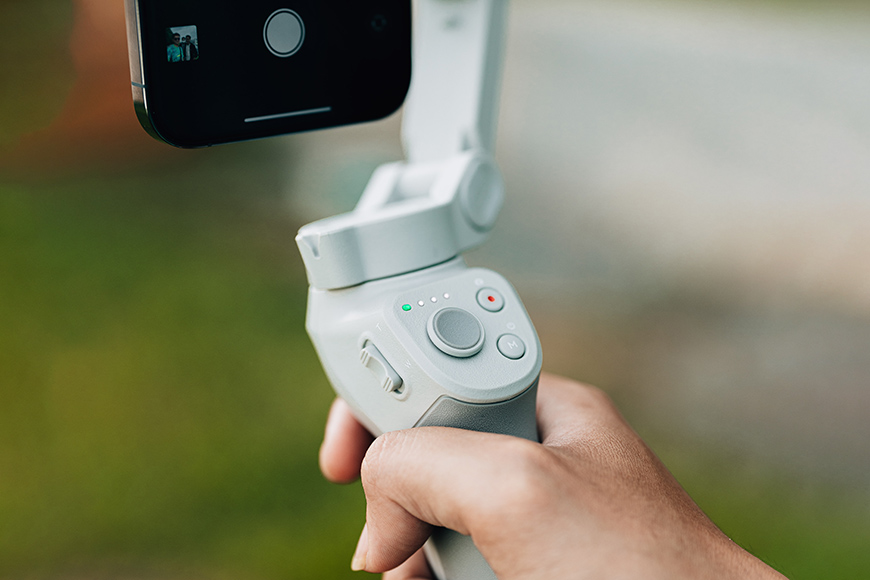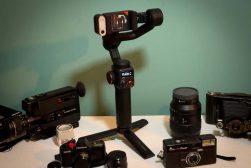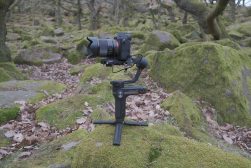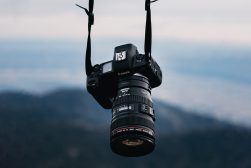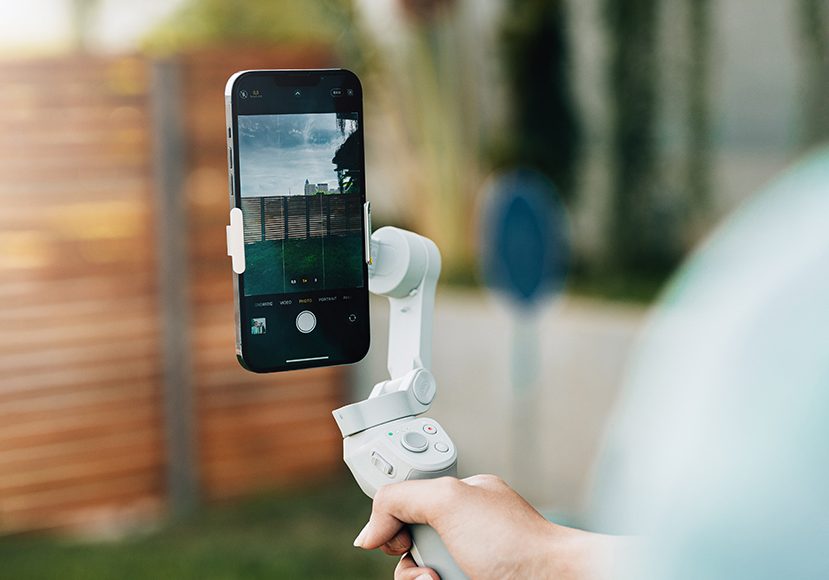
Best Smartphone Gimbal Stabilizers in 2024 (iPhone & Android)
Getting smooth smartphone footage isn't the only benefit of a smartphone gimbal stabilizer, but it's also true that not everyone needs one. Do you?
Shotkit may earn a commission on affiliate links. Learn more.
In a world where content creators can make thousands overnight, getting the best smartphone gimbal is important.
But before you splash your cash, think about whether your phone actually needs a gimbal.
Some of the latest iPhone and Android smartphones have stabilization so good (even better than modern mirrorless cameras) that gimbals aren’t even necessary.

Get impressively stable footage from this compact, portable gimbal with extendable selfie stick and useful face-tracking modes.
That said, a good gimbal for your phone can do more than simply stabilize your video footage.
The best models have features like AI face tracking, pan and tilt control, zoom and focus control and various shooting modes like panorama, time-lapse and slow motion.
Most gimbal stabilizer units come with a companion app that sometimes even provides video editing tools for your footage.
The best smartphone gimbals have an impressive battery life and can even double as a portable power bank to charge your phone while you’re shooting.
With that said, I took a look at a handful of the latest phone stabilizers to see which ones are worth your money.
What are the Best Smartphone Gimbals in 2024?
Insta360 Flow
- AI-enhanced subject tracking for superior performance
- Quick setup and ease of use, perfect for filmmakers on the go
- Lightweight, portable design, ensuring high mobility
- Integrated mini-tripod and extension pole, enhancing its versatility
- Innovative software features such as DeepTrack 3.0, gesture controls, Shot Genie and auto-editing for efficient content creation
- Limited tilt-axis movement, which could impact the smoothness of certain shots
- Variance in app functionality across different devices, potentially affecting user experience
The Insta360 Flow stood out to me as the best smartphone gimbal for iPhone and Android phones, with its brilliant AI tracking capabilities, robust software, and exceptional design. This is why many tout this as the best gimbal for iPhones.
The gimbal offers best-in-class subject tracking and impresses with its ease of use, quick setup, and lightweight, portable design.
The design includes innovative features like an integrated mini-tripod and extension pole.
The Insta360 Flow’s software includes features like DeepTrack 3.0, gesture controls, Shot Genie and auto-editing.
Its AI-enhanced tracking is considered superior to other gimbals in the market.
Despite its limited tilt-axis movement and variance in app functionality across devices, I found it to be the most well-rounded iPhone gimbal tested.
The Insta360 Flow pairs advanced software smarts with clever design, creating a versatile and portable tool for filmmakers.
The gimbal also includes an extension pole and built-in tripod, which enhance its utility and portability.
With these features and its top-notch performance, I recommend the Insta360 Flow as the gimbal stabilizer to buy for your phone in 2024.
DJI Osmo Mobile 6
- Excellent stabilization performance, ensuring smooth and professional video capture
- Support for multiple cameras on many phones, particularly iPhones, allowing for diverse shooting scenarios
- Compact design that folds up, enhancing portability and ease of use
- Included mini desk tripod and soft bag add value to the package
- Innovative features like Active Track 5.0 for automatic subject tracking, and a combined dial and button for zoom and focus
- Auto power-on feature when you unfold it, for quicker setup and use
- Telescopic pole built-in, useful for shooting from different heights
- Android application is not available in the Google Play Store, causing inconvenience for Android users
- Inability to adjust the sensitivity of the zoom wheel, which can cause difficulties in precise zooming
- Fill-light clamp is an additional cost, increasing the overall expense of the product
- On the higher end of the price range, making it less accessible for some users
The DJI Osmo Mobile 6 emerges as a standout gimbal, especially for iPhone users.
It features significant improvements including a handy display to indicate its mode and a combined dial and button for zoom and focus.
Its compact size when folded enhances its portability, making it easier for users to carry around. The package also includes a mini desk tripod and a soft bag. This alone makes it the best gimbal for phone photography and videography on the go.
The gimbal provides excellent stabilization performance and supports multiple camera lenses on many smartphones.
Its intuitive software and easy-to-use hardware make it a premium choice for mobile photography and videography.
The Active Track 5.0 allows automatic subject tracking, enhancing its usability for dynamic shooting scenarios.
Despite its strengths, the Osmo Mobile 6 has a few downsides.
The Android application is not available on the Google Play Store, creating inconvenience for Android users.
The sensitivity of the zoom wheel cannot be adjusted, and the fill-light clamp is an additional cost. However, despite these minor issues, it remains one of the top choices for smartphone gimbals.
Zhiyun Crane M3
- Versatile usage across smartphones, action cams, and mirrorless cameras
- Integrated dual temperature fill light for enhanced brightness and color control
- PD 12W fast charging and good battery life
- Responsive touchscreen and Bluetooth 5.0 for user-friendly operation
- Premium build quality
- Initial balancing can be challenging
- Battery changes with quick release plate require more disassembly
- Accessory options tied to specific packages
The Zhiyun Crane M3 stands as a versatile, professional-grade gimbal ideal for smartphones, action cams, and mirrorless cameras.
With a compact mount and quick-release system, it’s designed for convenient portability and usage.
It excels with integrated dual temperature fill light, providing extensive control over brightness and color.
Also notable is its PD 12W fast charging, powering a good battery life.
The gimbal is equipped with a responsive touchscreen and Bluetooth 5.0, adding to its user-friendly features.
Despite a few initial balancing issues and some challenges in battery changes with the quick-release plate, the Zhiyun Crane M3’s premium build quality and overall performance make it one of the best choices for both hobbyists and professionals.
Its multiple accessory options, however, are tied to specific packages.
DJI Osmo Mobile SE
- Smaller form factor and longer battery life compared to the Osmo Mobile 6
- Compatible with all accessories of the Osmo Mobile 6, including the magnetic phone clamp
- Offers Active Track technology for subject tracking
- Supports various shooting features like timelapse and panoramics
- Accepts a wide range of smartphones
- Similar to the Osmo Mobile 6, potentially leading to cannibalization of sales
- Limited information on additional unique features or improvements over its predecessor
The DJI Osmo Mobile SE is a cellphone gimbal that offers a compact form factor, longer battery life, and a more affordable price compared to the Osmo Mobile 6. Many of its fans even call this the best iPhone gimbal on the market.
It shares many similarities with its counterpart, including the same load capacity and compatibility with accessories like the magnetic phone clamp.
The gimbal features the newest Active Track technology for subject tracking and utilizes Bluetooth 5.1 for seamless communication with smartphones.
It offers a range of shooting features through the accompanying app, such as timelapse, panoramics, and hyper-lapse.
The Osmo Mobile SE can accommodate smartphones up to 3.3″ wide and weigh up to 10.2oz (290g).
Notably, it boasts a higher capacity battery than the Osmo Mobile 6, providing up to 8 hours of battery life.
However, the Osmo Mobile SE takes slightly longer to charge compared to its counterpart.
With its lower price and longer battery life, the Osmo Mobile SE presents an attractive alternative to the Osmo Mobile 6, potentially leading to cannibalization of sales for the latter.
Hohem iSteady M6
- Compact and lightweight design
- Magnetic fill light and AI vision sensor for enhanced video recordings
- Versatile mechanical range for smooth movements
- Controlled through the Hohem app with various shooting modes
- Long battery life of up to 18 hours
- Response time to movements may be slightly slow
- Learning curve to familiarize oneself with the various buttons and settings
The Hohem iSteady M6 is a compact 3-axis smartphone gimbal kit designed for YouTubers, streamers, and amateur filmmakers.
It includes a magnetic fill light and AI vision sensor for enhanced video recordings.
With a weight of 551g (including the battery), it can support smartphones weighing up to 400g and ranging in width from 58mm to 98mm.
The gimbal offers a mechanical range of 360° pan, 335° roll, and 335° tilt for smooth and versatile movements.
Controlled through the Hohem app, it features an AI tracking function that follows your face when you give the “OK” hand signal.
The OLED display shows essential information, and the gimbal offers various shooting modes and adjustable settings.
The battery has a capacity of 7.4V/19.24Wh, providing up to 18 hours of battery life.
While the gimbal performs well in stabilizing footage, response time to movements may be slightly slow.
With its solid build quality and unique AI feature, the Hohem iSteady M6 is a convenient tool for improving smartphone video quality, especially when familiarizing yourself with its functions to maximize its potential.
This iPhone stabilizer is a terrific addition to your videography gear.
Is a Phone Stabilizer Worth It? (Do You Actually Need a Smartphone Gimbal)
A phone stabilizer, such as a smartphone gimbal, can be worth it for those seeking to improve the quality of their smartphone videos.
While modern smartphones come equipped with built-in stabilization, they may not always be sufficient to eliminate all unwanted camera movements.
A phone stabilizer provides enhanced stability, resulting in smoother footage, professional-looking pans, and steadier shots.
Both Android and iPhone users can actually still benefit from smartphone gimbals.
Android smartphones like the Samsung Galaxy S21 Ultra and Google Pixel 6 Pro offer impressive camera capabilities, and pairing them with a stabilizer can further elevate the quality of their video recordings.
Similarly, iPhones like the iPhone 14 Pro Max excel in video shooting, and a smartphone gimbal can enhance their stabilization features, especially for cinematic movements.
Phone stabilizers also offer additional features such as active tracking, time-lapse, and creative shooting modes, expanding the creative possibilities for content creators. They provide greater control over the camera’s movements, allowing users to capture dynamic shots with ease.
However, it’s important to consider personal needs and usage patterns.
If you primarily use your smartphone for casual videos or social media content, a phone stabilizer may not be essential.
Built-in stabilization and editing tools may be sufficient for such purposes.
On the other hand, if you frequently shoot vlogs, travel videos, or professional content, investing in a phone stabilizer can significantly enhance the quality and overall production value of your videos.
Which smartphones already have great video stabilization?
Several modern smartphones excel in video stabilization, offering impressive built-in stabilization features. Here are some examples:
- iPhone 14 Pro Max: Apple’s latest flagship iPhone model boasts exceptional video stabilization capabilities. Its advanced sensor-shift optical image stabilization (OIS) system, combined with powerful computational algorithms, delivers smooth and steady footage even in challenging conditions.
- Samsung Galaxy S22+: The Galaxy S22 Ultra from Samsung features Super Steady video stabilization, utilizing a combination of OIS and electronic image stabilization (EIS) to deliver steady video recordings. It effectively reduces camera shake and ensures smoother footage.
- Google Pixel 7 Pro: Google’s Pixel smartphones are renowned for their exceptional camera performance, including video stabilization. The Pixel 6 Pro leverages both OIS and EIS to provide impressive stabilization, resulting in smooth and steady video recordings.
- OnePlus Pro 12: The OnePlus 9 Pro offers notable video stabilization capabilities. Its combination of OIS and EIS ensures less shaky footage, allowing for smooth panning and stable shots.
- Huawei P60 Pro: Huawei’s P40 Pro is equipped with advanced OIS and EIS technology, providing excellent video stabilization. Its stabilization algorithms compensate for various movements, resulting in smooth and jitter-free videos.
The stabilization in modern smartphones is much better than digital cameras attached and IBIS or similar built-in stabilization.
Even when you use a gimbal stabilizer with a digital camera, some smartphones can still provide smoother footage.
What Does a Cell Phone Stabilizer Actually Do?
A cell phone stabilizer, such as a smartphone gimbal, is a device designed to minimize camera shake and provide steady footage while capturing videos or taking photos with a smartphone.
It uses a combination of motors and sensors to counteract movements and maintain stability.
The gimbal’s three-axis system allows for smooth panning, tilting, and rolling motions, ensuring that the camera remains level and steady.
This results in professional-looking videos with reduced shakiness, smoother transitions, and improved image quality.
Additionally, some cell phone stabilizers offer advanced features like active tracking, time-lapse, and various shooting modes, further enhancing creative possibilities for content creators.
7 Tips for Stabilizing Your Phone (Without Smartphone Gimbals)
While a smartphone gimbal is a great tool for stabilizing your phone, there are also some techniques you can use to achieve smoother footage without one. Here are some tips for stabilizing your phone without a gimbal:
- Hold your phone with both hands: Ensure a firm grip on your phone using both hands, with your elbows close to your body. This helps minimize hand movements and provides better stability.
- Use your body as a camera stabilizer: Brace your arms against your chest or lean against a solid object like a wall or railing to provide additional support and stability while filming.
- Slow and steady movements: Avoid sudden or jerky movements while recording. Focus on slow and smooth motions to maintain stability and minimize shakiness.
- Use image stabilization features: Most smartphones offer built-in software-based image stabilization features. Enable this setting in your camera app to utilize the digital stabilization capabilities of your phone.
- Utilize a tripod or stabilize on a surface: Place your phone on a stable surface or use a tripod to eliminate hand movements altogether. This is especially useful for static shots or time-lapse recordings.
- Avoid zooming in: Zooming in on your subject amplifies any camera movements, resulting in shakier footage. Instead, physically move closer to your subject whenever possible.
- Edit and stabilize in post-production: If you have slightly shaky footage, you can utilize video editing software or apps to stabilize the footage during the post-production process.
While these tips can help improve stability, it’s important to note that a smartphone gimbal provides the best results for professional-level stabilization.
FAQs: Keeping your camera steady
What is the difference between a gimbal and a stabilizer?
A gimbal is a specific type of stabilizer that utilizes motorized three-axis movement to actively stabilize the camera, while a stabilizer can refer to any device or technique used to reduce camera shake.
What are the disadvantages of a gimbal?
The disadvantages of a gimbal include their cost, additional weight and bulkiness, and the need for power or battery to operate, which can limit their portability and convenience in certain situations.
Which brand phone gimbal stabilizer is best?
There are several top brands known for producing high-quality phone gimbal stabilizers, including DJI, Zhiyun, and Hohem. The best brand for you will depend on your specific needs, budget, and desired features.
Is it necessary to have a gimbal on your phone?
While a gimbal can greatly enhance the stability and smoothness of your phone videos, it is not necessary for everyone.
If you primarily shoot casual videos or don’t require professional-level stabilization, you can achieve satisfactory results with built-in stabilization features or handheld techniques.
Should I turn off image stabilization when using a gimbal?
It is generally recommended to turn off image stabilization on your phone when using a gimbal. The gimbal’s motors and stabilization algorithms work best when they have full control over the camera movements.
Having both image stabilization systems active simultaneously can potentially cause conflicts and result in less effective stabilization.
What are some popular gimbal apps for smartphones?
Here are a few gimbal apps that can be used in conjunction with smartphone gimbals, or on their own:
- DJI Mimo: This is the official app for DJI’s smartphone gimbals, like the Osmo Mobile series. The app offers various shooting modes like panorama, timelapse, motionlapse, and hyperlapse. It also provides video editing options.
- Zhiyun’s ZY Play: This app is designed for Zhiyun’s line of smartphone gimbals. It offers different shooting modes including time-lapse, slow-motion, long exposure, and panorama. It also has object tracking, focus control, and exposure settings.
- Feiyu ON: Designed for FeiyuTech’s smartphone gimbals, this app includes a variety of functions like face tracking, time-lapse, panoramic, and light painting modes.
- Moza Genie: This is the official app for MOZA’s smartphone gimbals. It provides various shooting modes and offers video editing capabilities, with filters, templates, and special effects.
- Freevision VILTA: Freevision’s app offers different filming modes including panorama, timelapse, motion timelapse, and more. It also features object tracking and various settings to fine-tune your videos.
- Hohem Gimbal: The Hohem Gimbal app offers features like face tracking, auto-editing, and a variety of shooting modes like time-lapse and motion-lapse for their smartphone gimbals.

Get impressively stable footage from this compact, portable gimbal with extendable selfie stick and useful face-tracking modes.





